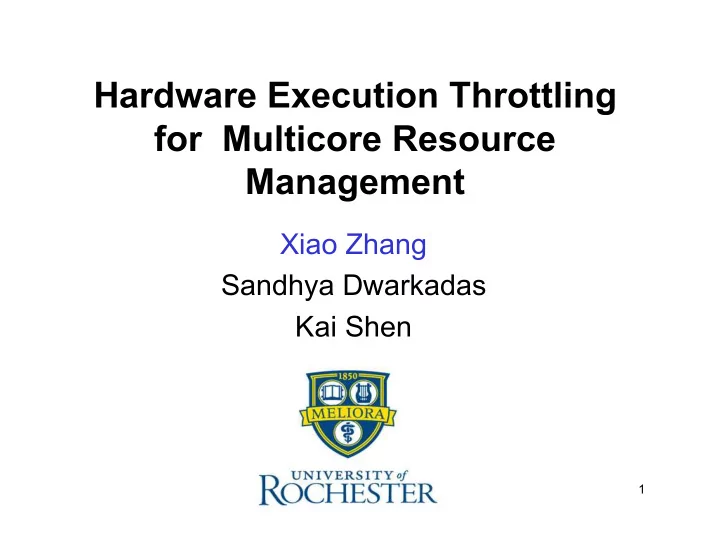

Hardware Execution Throttling for Multicore Resource Management Xiao Zhang Sandhya Dwarkadas Kai Shen 1
The Multi-Core Challenge • Multi-core chip – Dominant on market – Last level on-chip cache is commonly shared by sibling cores, however sharing is not well controlled • Challenge: Performance Isolation source: http://www.intel.com – Poor & unpredictable performance – Denial of service attacks 2
A Full Solution Includes … • Good mechanism – Should be both efficient and practical to deploy – Main focus of this talk • Good policy to govern mechanism – as important as mechanism, and not easy – Omitted in this talk 3
Existing Mechanism(I): Software based Page Coloring • Classic technique originally used to Thread A’s footprint Memory page reduce cache miss, recently used A1 by OS to manage cache partitioning A2 • Partition cache at coarse A3 granularity Thread A • No need for hardware A4 support Thread B A5 Way-1 ………… Way-n Shared Cache
Existing Mechanism(II): Scheduling Quantum Adjustment • Shorten the time quantum of app that overuses cache • May let core idle if there is no other active thread available Core 0 Thread A idle Thread A idle Thread A idle Core 1 Thread B Thread B Thread B time 5
New Mechanism: Hardware Execution Throttling • Throttle the execution speed of app that overuses cache – Duty cycle modulation • CPU works only in duty cycles and stalls in non-duty cycles • Allow per-core control (vs. per-processor control for existing Dynamic Voltage Frequency Scaling) – Enable/disable cache prefetchers • L1 prefetchers – IP: keeps per-instruction load history to detect stride pattern – DCU: prefetches next line when it detects multiple loads from the same line within a time limit • L2 prefetchers – Adjacent line: Prefetches the adjacent line of required data – Stream: looks at streams of data for regular patterns
Brief View of Hardware Execution Throttling • Comparison to page coloring – Little complexity to kernel • Code length: 40 lines in a single file (as a reference our page coloring implementation takes 700+ lines of code crossing 10+ files) – Lightweight to configure • Read plus write register: duty-cycle 265 + 350 cycles, prefetcher 298 + 2065 cycles, which is less than 1 microsecond on a 3Ghz CPU (as a reference re- coloring a page takes 3 microseconds on the same CPU) • Comparison to scheduling quantum adjustment – More fine-grained controlling Quantum adjustment Hardware execution throttling Core 0 Thread A idle 7 Core 1 Thread B time
Evaluation • Candidate mechanisms – Page coloring – Scheduling quantum adjustment – Hardware execution throttling • Experiment setup – Conducted on a 3.0 Ghz Intel dual-core processor – 3 SPECCPU-2000 apps (swim, mcf, & equake) and 2 server-style apps (SPECjbb2005 & SPECweb99), running all possible pair-wise co-schedule • Goal: evaluate their effectiveness in providing performance fairness – For each mechanism, tune its configuration offline to achieve best fairness 8
Fairness Comparison • Unfairness factor: coefficient of variation (deviation- to-mean ratio, σ / μ ) of co-running apps’ normalized performances • On average all three mechanisms are effective in improving fairness • Case {swim, SPECweb} illustrates limitation of page coloring 9
Performance Comparison • System efficiency: geometric mean of co-running apps’ normalized performances • On average all three mechanisms achieve system efficiency comparable to default sharing • Case where severe inter- thread cache conflicts exist favors segregation, e.g. {swim, mcf} • Case where well-interleaved cache accesses exist favors sharing, e.g. {mcf, mcf} 10
Drawbacks of Page Coloring • Expensive re-coloring cost – Prohibitive in a dynamic environment where frequent re-coloring may be necessary Thread A’s footprint A1 • Complex memory management – Introduces artificial memory pressure A2 A3 Way-1 ………… Way-n Thread A A4 Thread B A5 For more details on tackling these problems, please read our Eurosys’09 paper: Shared Cache Practical Page coloring based Multi-core Memory page Cache Management
Drawback of Scheduling Quantum Adjustment • Coarse-grained control at scheduling quantum granularity may result in fluctuating service delays for individual transactions 12
Summary • Hardware execution throttling mechanism for multi-core cache management – Fine-grained control – Lightweight solution that cleverly reuses existing hardware features – System efficiency is competitive to default sharing, largely comparable to scheduling quantum adjustment, but inferior to ideal page coloring • Future work – Investigate policy for online configuration 13
Recommend
More recommend